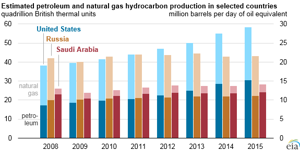EIA: US remains top petroleum and natural gas hydrocarbons producer

According to estimates published by the US Energy Information Administration (EIA), the US continued to hold the top position in the global production of petroleum and natural gas hydrocarbons in 2015.
The US has been the world's top producer of natural gas since 2011, and its petroleum and natural gas production first surpassed Russia in 2012. The US has been the world's top producer of petroleum hydrocarbons since 2013.
For both the US and Russia, total petroleum and natural gas hydrocarbon production is evenly split between petroleum and natural gas. On the other hand, Saudi Arabia's production heavily favors petroleum. Total petroleum production is made up of several different types of liquid fuels, including crude oil and lease condensate, tight oil, extra-heavy oil and bitumen. Through various processes, natural gas plant liquids (NGPL), biofuels and refinery processing gain, among other possible liquid fuels, are produced.
US crude oil and lease condensate accounted for roughly 60% of the total petroleum hydrocarbon production in 2015, according to EIA statistics. Natural gas plant liquids counted for an additional 20%, with biofuels and refinery processing gain making up most of the remaining petroleum and other liquids production.
Despite low crude oil prices and a 60% drop in the number of operating oil and natural gas rigs, US petroleum supply still increased by 1 MMbpd in 2015. The country’s natural gas production increased by 3.7 Bcfd, mostly from the eastern US.
The increase in petroleum and natural gas production can be directly attributed to production from tight oil and shale gas formations. Several factors kept hydrocarbon production increases in Russia lower than those in the US. In Russia, natural gas production declined due to poor economic conditions and a mild winter, which resulted in lower domestic natural gas demand. Russia's total combined production of petroleum and natural gas increased by just 0.1 quadrillion Btu in 2015.
Because Saudi Arabia did not reduce petroleum production in late 2014 or 2015, even as oil prices fell and global inventories of oil rose, the country’s total petroleum and natural gas hydrocarbon production rose by 3% in 2015. However, the US produced more than twice Saudi Arabia’s petroleum and natural gas hydrocarbons in 2015.






Comments